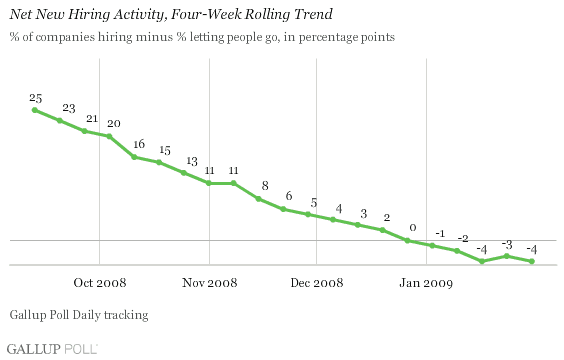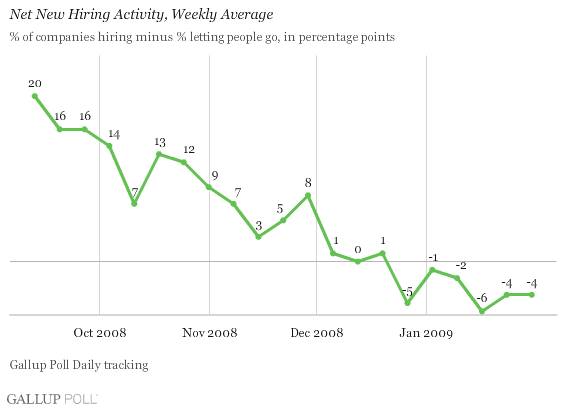PRINCETON, NJ -- for the four weeks ending Jan. 31 fell to -4 from -3 the previous week, suggesting that on Thursday, the Labor Department is likely to report a surge past 565,000 in the seasonally adjusted four-week moving average of jobless claims -- up from 542,500 the previous week.

The surge in the four-week moving average is due in part to the roll-off of some low numbers reported early this year and in part to the continued high level of jobless claims in recent weeks.
Gallup's New Hiring Measure Remains Negative
Gallup's weekly new hiring measure, like its rolling four-week measure, shows that U.S. employees' perceptions of the job situation at their companies remain negative -- at -4 for the week ending Jan 31. In turn, this suggests the job market continues to weaken, with this Thursday's government report of weekly jobless claims likely to remain near or even move slightly higher than last week's 588,000. Still, predicting small changes in weekly claims tends to be difficult given their volatility, particularly when seasonal adjustments are applied to them at this time of year. In this regard, Gallup's four-week moving average of jobless claims is not only a more stable but also a better predictor of actual conditions in the job market.

Jobs Continue to Disappear
Gallup's new hiring measure suggests that the U.S. economy is continuing to lose more than 125,000 jobs each week. Given this context, it might be assumed that the new and unprecedented fiscal stimulus plan moving through Congress would be focused on ways to "slow the bleeding" in the job market and recapture consumer confidence. Unfortunately, most Americans don't seem to think this will be the case, with .
Congress needs to remember as it works its legislative will that this new stimulus effort needs to be almost as much psychological as economic. Right now, consumers are afraid to spend because they see the economy in a virtual free-fall, and their most reasonable course of action is to hunker down. While substituting government spending for private spending may provide some short-term benefits, behavioral economics suggests that success will be achieved only if this effort can instill in consumers new confidence that the overall economy will soon improve.
In turn, the only way the stimulus plan can really change the current consumer psychology is for the nation's leaders, both on Main Street and on Wall Street, to come to a consensus that the effort will succeed -- creating new jobs and bringing the downward spiral of the economy to a halt. Right now, Americans don't seem to believe the current plan will achieve these goals. If that continues to be the case, then the majority of Americans are likely to be right in their assessment that this unprecedented spending plan will do too little, too late in the face of the current jobs crisis.
Gallup.Com reports on its every Tuesday.
Survey Methods
Using weekly results for 2008, Gallup's analysis suggests that its hiring measure has a better than 7-in-10 probability of correctly projecting the direction of weekly jobless claims and a better than 8-in-10 probability of predicting the direction of the four-week average of jobless claims.
Gallup's hiring measure is based on aggregated interviews with a nationally representative sample of more than 2,000 U.S. workers each week. 优蜜传媒asks current full- and part-time employees whether their employers are hiring new people and expanding the size of their workforces, not changing the size of their workforces, or letting people go and reducing the size of their workforces. Gallup's hiring measure is computed by subtracting the "letting go and reducing" percentage from the "hiring and expanding" percentage. The assumption is that employees across the country have a good feel for what's happening in their companies, and that these insider perceptions can yield a meaningful indication of the nation's job situation.
Gallup's Net New Hiring Activity measure was initiated in January 2008. It is an effort to assess U.S. job creation or elimination based on the self-reports of more than 2,000 individual employees aggregated each week about hiring and firing activity at their workplaces. For results based on these samples, the maximum margin of sampling error is 卤3 percentage points.
Interviews are conducted with respondents on land-line telephones (for respondents with a land-line telephone) and cellular phones (for respondents who are cell-phone only).
In addition to sampling error, question wording and practical difficulties in conducting surveys can introduce error or bias into the findings of public opinion polls.
